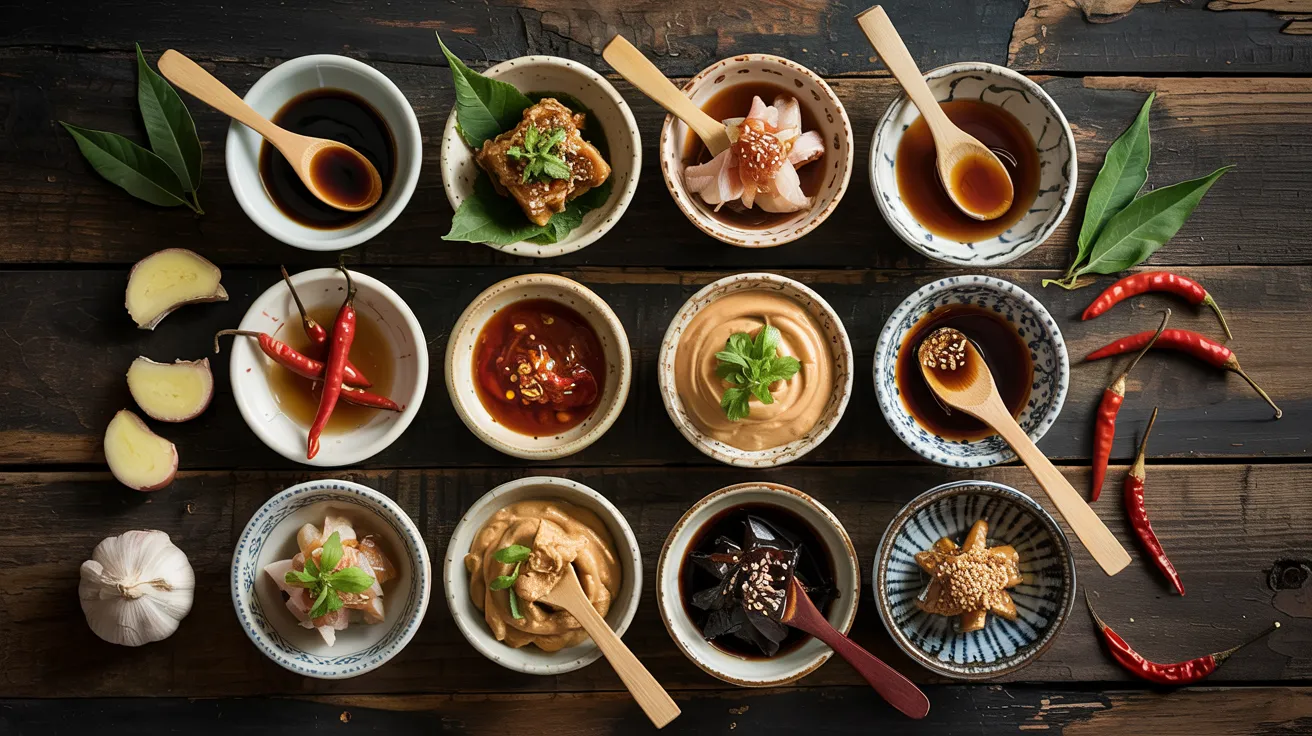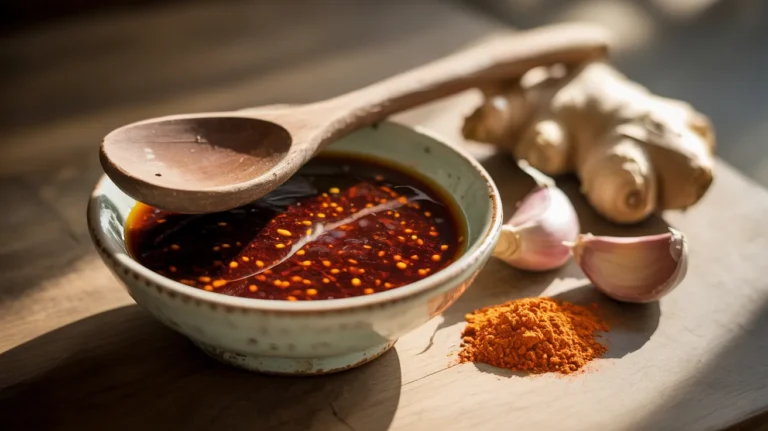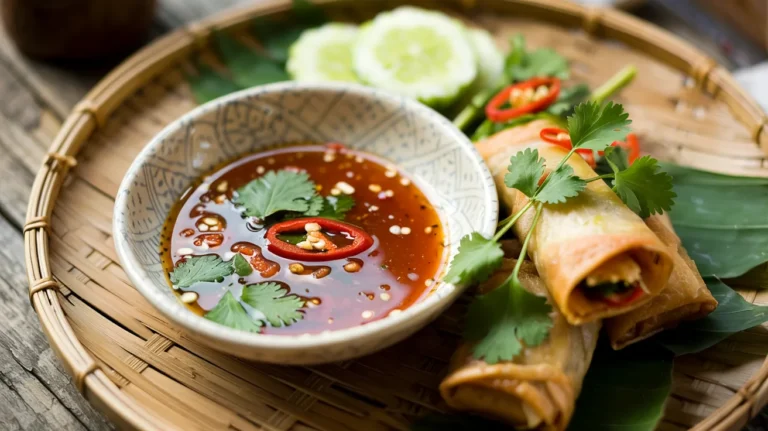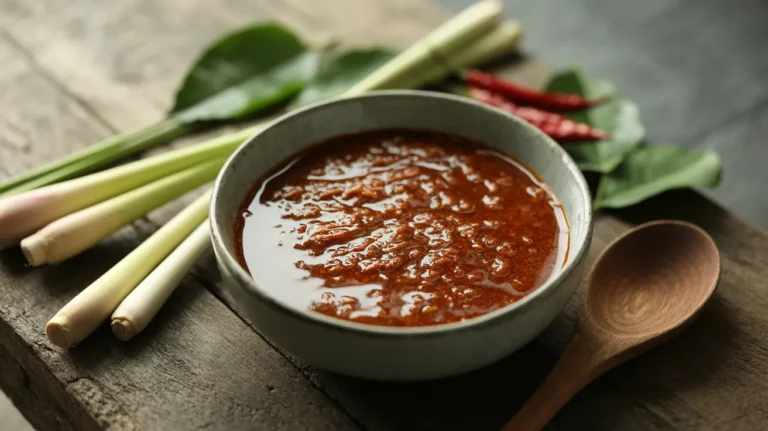Asian inspired sauces can turn an ordinary meal into something extraordinary. Whether you’re whipping up a quick weeknight dinner or impressing guests, these flavor-packed condiments add depth and character to any dish.
I’ve spent years perfecting these sauce recipes in my home kitchen, and I’m excited to share what makes each one special. Let’s explore these versatile kitchen staples that will level up your cooking instantly.
Stir Fry Sauce
A good stir fry sauce is the secret weapon in quick, flavorful meals. This kitchen essential combines salty, sweet, and umami notes in perfect harmony.
The magic happens when you mix soy sauce, rice vinegar, and a touch of honey. Add garlic, ginger, and a splash of sesame oil for depth.
What sets great stir fry sauce apart is balance. Too sweet? Add acid. Too salty? A bit more honey helps mellow it out.
Store homemade stir fry sauce in an airtight container for up to two weeks. It’s worth making a big batch – you’ll reach for it constantly!
Quick Stir Fry Sauce Variations
| Base | Sweetener | Aromatics | Special Touch |
|---|---|---|---|
| Soy sauce | Brown sugar | Garlic, ginger | Sesame oil |
| Tamari | Honey | Lemongrass | Rice wine |
| Coconut aminos | Maple syrup | Shallot | Chili oil |
Hoisin Sauce
Hoisin sauce delivers a rich, complex sweetness that’s impossible to resist. This thick, fragrant sauce is like Asian barbecue sauce – but so much more.
The key ingredients include fermented soybeans, garlic, sesame, chiles, and sweet potato. This combination creates deep, complex flavors that enhance everything from duck pancakes to simple veggie dishes.
I love adding a spoonful to marinades or using it as a glaze for roasted vegetables. Try mixing it with lime juice for a quick dipping sauce that will wow your taste buds.
Best Uses for Asian Inspired Hoisin Sauce
- Glazing meats before grilling
- Adding depth to stir-fries
- Mixing into noodle dishes
- Using as a dipping sauce for spring rolls
- Spreading on wraps and sandwiches
Teriyaki Sauce
Teriyaki sauce brings the perfect balance of sweet and savory with its glossy, caramelized finish. This Japanese classic transforms ordinary proteins into spectacular dishes.
Traditional teriyaki combines soy sauce, mirin, sake, and sugar, simmered until thickened. The mixture creates a beautiful glaze that clings to food and caramelizes when heated.
For an authentic touch, try using brown sugar instead of white – it adds depth and complexity to the sauce.
Teriyaki Glaze vs. Sauce
What’s the difference? Glaze is thicker and more concentrated, perfect for brushing onto food during cooking. Sauce is thinner and better for marinating or serving alongside dishes.
To create a quick teriyaki glaze, simply reduce your sauce longer until it coats the back of a spoon.
Mirin Sauce
Mirin sauce brings subtle sweetness and complex flavor to Japanese cooking. This golden rice wine contains natural sugars that create beautiful caramelization.
Unlike sake, mirin is specifically for cooking and adds a distinct flavor impossible to replicate. When heated, it loses its alcohol content but keeps its unique sweet profile.
I find mirin essential for authentic flavor. It balances the saltiness of soy sauce perfectly and adds dimension to simple broths and marinades.
Creative Uses for Mirin
Try adding mirin to:
- Salad dressings for subtle sweetness
- Marinades for fish and chicken
- Soup bases for added depth
- Glazes for roasted vegetables
- Quick pickles for balance
Sweet Chili Sauce
Sweet chili sauce delivers the perfect balance of sweetness and heat. This vibrant sauce is incredibly versatile, working with everything from spring rolls to grilled chicken.
The signature red color comes from fresh chilies, while sugar, garlic, and vinegar round out the flavor profile. Some versions include ginger for extra warmth.
Making this sauce at home allows you to control the heat level. Remove seeds from chilies for milder sauce, or leave them in for extra kick.
Asian Inspired Sweet Chili Heat Scale
| Style | Heat Level | Best Paired With |
|---|---|---|
| Mild | 🌶️ | Vegetable spring rolls, mild fish |
| Medium | 🌶️🌶️ | Chicken, shrimp, tofu dishes |
| Hot | 🌶️🌶️🌶️ | Heartier meats, dumplings |

Thai Tamarind Sauce
Thai tamarind sauce delivers a tangy, sweet-sour punch that makes taste buds dance. This complex sauce balances the natural sourness of tamarind with palm sugar sweetness.
Authentic tamarind sauce starts with the pulp of the tamarind fruit, which gives it an unmistakable tang. When combined with palm sugar, fish sauce, and chilies, it creates the perfect balance of flavors.
I love how versatile this sauce is – it works as a glaze, dipping sauce, or stir-fry addition. Try it with grilled shrimp for an unforgettable flavor combination.
Key Tamarind Sauce Components
- Tamarind pulp: Provides signature sourness
- Palm sugar: Adds caramel-like sweetness
- Fish sauce: Delivers umami depth
- Garlic and chilies: Bring heat and dimension
Thai Peanut Sauce
Thai peanut sauce combines creamy richness with complex flavor notes. This velvety sauce features ground peanuts, coconut milk, and aromatic spices.
The secret to great peanut sauce is balance. Red curry paste adds depth, while lime juice cuts through the richness. A touch of brown sugar harmonizes everything.
For extra texture, I like keeping some peanuts roughly chopped rather than fully blended. This creates little pockets of crunch in the smooth sauce.
Thai Peanut Sauce Applications
This versatile sauce works beautifully as:
- Dipping sauce for fresh spring rolls
- Salad dressing (thinned with lime juice)
- Marinade for grilled chicken satay
- Sauce for rice noodle dishes
- Drizzle for roasted vegetables
Homemade Unagi Sauce
Homemade unagi sauce delivers rich, sweet-savory flavor perfect for grilled eel, chicken, or vegetables. This Japanese classic is simpler than you might think.
Traditional unagi sauce combines soy sauce, mirin, sake, and sugar, reduced until thick and glossy. The result is intensely flavorful and addictively good.
When making at home, patience is key. A slow reduction creates deep caramelization without burning the sugars. Watch closely and stir occasionally as it thickens.
Beyond Eel: Creative Unagi Sauce Uses
While traditionally paired with grilled eel, try unagi sauce with:
- Grilled chicken or salmon
- Drizzled over rice bowls
- Brushed onto roasted mushrooms
- Added to vegetable stir-fries
- Mixed into burger patties
Miso Black Garlic Sauce
Miso black garlic sauce offers incredible depth and umami richness. This innovative combination brings together fermented flavors that transform any dish.
Black garlic – regular garlic fermented until soft and sweet – adds caramel notes without bitterness. When combined with miso paste, it creates a sauce with remarkable complexity.
I find this sauce particularly amazing with simple proteins like grilled fish or chicken. Just a small amount adds tremendous flavor dimension.
Types of Miso for Your Sauce
| Miso Type | Flavor Profile | Best Used With |
|---|---|---|
| White (Shiro) | Mild, sweet | Delicate fish, chicken |
| Yellow (Shinsu) | Medium strength | Vegetables, tofu |
| Red (Aka) | Strong, robust | Hearty meats, stews |
Why Asian-Inspired Sauces Are Kitchen Essentials
These nine Asian-inspired sauces will expand your cooking repertoire and inspire countless creative dishes. Experiment with different combinations and find your favorites – your taste buds will thank you!
Meta description: Discover 9 amazing Asian-inspired sauces that will transform your home cooking. From classic teriyaki to exotic miso black garlic, these flavor-packed condiments elevate any meal.




